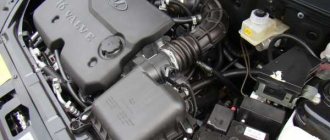For many owners of a practical Kia Rio model, such an indicator as the volume of the fuel tank is almost of paramount importance. This point is especially acute for owners who often have to travel long distances or go abroad, where, as we know, fuel is more expensive. This point is also relevant for people living in areas where gas stations are quite small. After refueling, the owner should correctly calculate his fuel supply in order to avoid the risk of stopping in a deserted area and with an empty tank. In this article we will talk about the volume of the tank on this machine.
Overall dimensions, mm)
| Length | 4 240 |
| Width | 1 750 |
| Height | 1 535 |
| Wheelbase | 2 600 |
| Front wheel track | 1 507 — 1 513 |
| Rear wheel track | 1 524 — 1 530 |
| Front overhang | 845 |
| Rear overhang | 795 |
| Ground clearance | 195 mm with R16 wheels, 190 mm with R15 wheels |
Dimensions of KIA Rio X Line
tank volume, how many liters is the gas tank
The tank volume of the Kia Rio is the most important indicator for many thousands of owners of this unpretentious and reliable vehicle. When going on a long trip abroad, where gasoline is much more expensive, or to an area with rare gas stations, the driver must clearly calculate the required amount of fuel reserves so as not to be left with an empty tank in the middle of a field or somewhere in a deserted area.
Gas tank location
The Kia Rio car is designed with unconditional compliance with vehicle safety regulations. Its fuel tank is located in the most protected point of the car: near the rear of the car in the luggage compartment area.
The location of the gasoline tank is not very close to the rear bumper, approximately half a meter separates them. This distance is sufficient for the safety of people inside the car in the event of a rear collision with an obstacle or road users. A pump is installed in the car’s gas tank, which forces gasoline into the main pipelines, and an adsorber for a system for collecting emitted fuel vapors.
Specifications
The capacity of the gas tank depends on many additional factors. According to the passport data, the fuel storage capacity of the Kia Rio is 45 liters. On hot summer days, due to temperature expansion, it is not recommended to fill gasoline to capacity, that is, to the upper edge of the neck.
Taking into account safety requirements, in order to ensure sufficient thermal expansion of the medium, it is necessary to calculate an adjustment for the filling capacity of the gasoline tank.
How the fuel tank works
The Kia Rio gas tank is made of duralumin alloy. Two stamped halves are welded into a single whole - a sealed container is obtained. The device is equipped with the following products:
- fuel filler pipe;
- fuel filter;
- fastening tape;
- high pressure fuel pump;
- fuel pipe.
Many articles have been written on the Internet about tank removal, including step-by-step dismantling instructions. Brief repair recommendations are given below.
Examination
To check the tightness of the gas tank, you need to use a compressor and a hose. Having tightly closed all pipelines and holes with fittings, compressed air must be pumped into the tank. Maintain pressure of two or more atmospheres. After approximately two atmospheres, the safety valve should relieve pressure. If the plug is in good working order, the return flow will not interfere.
Sometimes the manufacturer installs a valve in the plug, but instead there may be a simple calibrated hole. In some Kia Rio models, excess pressure is released not by a plug in the gas tank, but by a special valve located on the fuel line. The tube is connected to the atmosphere, gases are released into the environment.
Repair
Leaks, damage, cracks, and holes in the fuel tank are repaired using epoxy resin or a “cold welding” kit. Epoxy resin is sold in a set with a hardener. The metal surface must be cleaned and degreased with anti-silicone.
Using your fingers, knead the structure of the cold welding bar. Make a flat patch that looks like a pancake. Apply it to the damaged area and rub the edges into the metal. The gas tank can be used one hour after hardening. Cold welded material does not react with gasoline, diesel fuel, oils, and antifreeze.
Conclusion
After filling the tank with fuel, you can hit the road. Now you have complete confidence that gasoline will not leak. A reserve of 45 liters is enough for approximately a distance of 650 kilometers. Bon voyage, driver, no nail, no rod!
Engines
| engine's type | Petrol | |
| Engine technology | MPI | |
| Engine capacity (l) | 1.4 | 1.6 |
| Maximum power (hp) | 99.6 | 123.0 |
| Maximum power (rpm) | 6 000 | 6 300 |
| Maximum torque (Nm) | 132.0 | 151.0 |
| Maximum torque (rpm) | 4 000 | 4 850 |
| Working volume (cm³) | 1 368 | 1 591 |
| Bore x Stroke (mm) | 72.0 x 84.0 | 77.0 x 85.4 |
| Compression ratio | 10.5 | |
| Maximum power (KW (rpm) | 73.3/6 000 | 90.2/6 300 |
| Gas distribution mechanism | 16 valve, with variable valve timing system for intake and exhaust valves (D-CVVT) | |
| Fuel system | Electronically controlled multipoint fuel injection | |
| Fuel requirements | Unleaded gasoline with an octane rating of at least 92 | |
| Engine oil volume (l) | 3.3 | |
| Number of cylinders and arrangement | 4, Row | |
| Environmental class | Euro 5 | |
KIA Rio X Line engines
Design
The new model, in comparison with the previous version, has become more Asian. This effect was achieved by slanted headlights with imitation eyelashes, a special bumper and neat daytime running lights. The signature radiator grille with fine perforations is also located here. From the side you can see the sports fuse of the sedan with the original glass edging.
There are no striking changes in the three-door interior. The three-spoke steering wheel “hides” the usual wells and a 3.5-inch on-board computer screen. There is a “floating” microclimate control unit located here, which is even available in the base. Kia, as always, is distinguished by an abundance of “warm” options, since it was manufactured specifically for Russia.
Transmission
| Engine | 1.4 (100 hp) | 1.4 (100 hp) | 1.6 (123 hp) | 1.6 (123 hp) |
| type of drive | Front | |||
| Transmission type | MT | AT | MT | AT |
| Number of gears | 6 | |||
| Clutch type | Dry, single disc | Hydraulic coupling | Dry, single disc | Hydraulic coupling |
| Transmission oil volume (l) | 1.6-1.7 | 6.7 | 1.6-1.7 | 6.7 |
Automatic Kia Rio X-Line
From Alpha to Gamma
The Russian consumer was offered a sedan, and then a hatchback, with two gasoline engines. The first models were called Alpha and did not undergo changes for a long time. The Russian version of the car has improved Gamma engines. Their serial designation is G4AE. The engines have a single-row arrangement of four cylinders, each of which has 4 valves. Thanks to the designers, “Gamma” turned out to be much more successful than its predecessor. This is noticeable by the following signs:
- The timing belt is missing. Now a reliable chain drive is used instead;
- The intake valve location has been changed so that the manifolds are located at the front of the unit, which allows for better cooling, more efficient fuel delivery and increased power;
- The location of the mounted units has changed, which has reduced the occurrence of some problems;
- The engines received plastic intake manifolds. This affected the smoothness of fuel delivery and improved noise characteristics;
- The valves were left without hydraulic compensation. This change simplified maintenance.
In addition, completely new approaches were used in Gamma engines, which had a beneficial effect on technical characteristics. In particular:
- The spark plugs were positioned in a new way and began to receive more cooling, which reduced fuel consumption;
- The cooling jacket has increased, reducing the temperature of the gases at the outlet;
- The displacement of the axis between the crankshaft and the center of the cylinder reduced friction and increased engine life;
- The lightweight aluminum block has become more rigid and reliable.
It is safe to say that the third generation Kia Rio engines represent a completely new series, which is in no way comparable to the engines of the second, and especially the first generation of Korean cars. For greater confidence, you can add improved generator operation. When accelerating, it reduces its power, sparing the engine. During braking, the opposite happens. Now the generator can effectively charge the battery when idling. Due to the double thermostat in the cooling system, a faster warm-up mode for the engine is obtained.
Dynamics
| Engine | 1.4 (100 hp) | 1.4 (100 hp) | 1.6 (123 hp) | 1.6 (123 hp) |
| Acceleration 0 - 100 km/h | 12.6 | 13.4 | 10.7 | 11.6 |
| Acceleration 80 - 120 km/h | 16.9 | 10.1 | 15.0 | 8.7 |
| Maximum speed km/h | 176 | 174 | 184 | 183 |
Salon
The interior completely matches the exterior. It has also lost all “Asian motifs” and has an attractive, strict and laconic European style.
The Kia Rio central console is not cluttered with a large number of control units. In the central part there is a 7-inch display of the multimedia system. Immediately below it there is a separate control unit for the car’s climate system with intuitive adjustments. A stylish steering wheel with a metal insert in its lower part fits well into this whole picture. It has control buttons symmetrically located on both sides.
The dashboard is no longer overloaded with unnecessary “decorations”. Everything looks “clean” and concise. On the left is a huge tachometer scale, in the middle is a color display, and on the right is a speedometer scale identical to the tachometer. The designers very beautifully connected the multimedia unit, central vents and dashboard using a single visor on the panel. Unfortunately, all beauty data is available only for the “top”. In the basic configuration of the KIA Rio, everything is much simpler.
One cannot help but be pleased with the fact that the interior is assembled very carefully from high-quality materials. The well-thought-out ergonomics are also pleasing. From the new Kia Rio, apparently, you won’t soon have to expect a large number of “crickets” and extraneous noise in the cabin, which is generally not typical for budget “B” class sedans.
The front seats of the updated Kia were also pleasantly surprised. They have pronounced lateral support, an optimal profile, a wide range of adjustments and heating. Everything is simple at the back, but even there everything is done neatly and pleasantly. Some may not have enough headroom.
For this class of car there is a quite acceptable luggage compartment, the volume of which is 480 liters. The rear seats can be folded in a 2:3 ratio. Unfortunately, the engineers from the Kiya company were unable to achieve a level floor, but under the raised floor the owners are pleased with a full-size spare wheel and a set of tools necessary for the road.
Fuel efficiency
| Engine | 1.4 (100 hp) | 1.4 (100 hp) | 1.6 (123 hp) | 1.6 (123 hp) |
| Fuel consumption (l/100 km) Combined | 5.9 | 6.6 | 6.8 | |
| City (l/100 km) | 7.4 | 8.6 | 8.7 | 8.9 |
| Route (l/100 km) | 5.0 | 5.4 | 5.6 | |
| Fuel tank volume (l) | 50 | |||
What is the fuel tank capacity of the 3rd and 4th generation Kia Rio?
Modern life cannot be imagined without technology and cars. Moving should be positive and comfortable, which is why many people decide to buy a car. It must meet expectations - be reliable, high-quality, ergonomic.
The fuel consumption indicator is also important, since this indicator can be used to determine whether operation will be economical or whether financial investments will be required.
One of the most popular cars in our country is the Kia Rio - a compact and maneuverable, lightweight and reliable option for family trips and getting around the city.
This model is distinguished by a well-thought-out design, the presence of all the functions necessary for a comfortable trip, and safety that meets international standards.
When choosing this brand as their main means of transportation, most potential owners pay attention not only to functionality and build quality, but also to the capacity of the gas tank of the car version chosen for purchase.
Weight (kg)
| Engine | 1.4 (100 hp) | 1.4 (100 hp) | 1.6 (123 hp) | 1.6 (123 hp) |
| Curb minimum | 1 155 | 1 187 | 1 175 | 1 203 |
| Curb maximum | 1 221 | 1 253 | 1 241 | 1 269 |
| Full mass | 1 570 | 1 610 | 1 590 | 1 620 |
Model body
Suspension
The fourth generation has an independent MacPherson strut suspension at the front, which is no different from the suspension of its predecessor.
The engineers worked hard on the rear suspension. A semi-independent system was installed on an elastic beam. The car is equipped with both transverse stabilizers and hydraulic shock absorbers. In the fourth generation, the shock absorbers are now vertical, not tilted as they were before.
What buyers may not like is the lack of protection on the bottom of the car.
pros
Most of the advantages of the new fourth generation KIA Rio 2019-2020 were described throughout the article, but it is worth highlighting separately:
- Automatic driver's windows in both directions;
- Cheap trim levels have parking sensors, expensive ones have a rear view camera with dynamic prompts;
- Due to the increase in dimensions, the cabin has become noticeably more spacious;
- Heated steering wheel, glass, seats, mirrors;
- Huge armrest with soft floor;
- Build quality;
- The quality of materials used for interior decoration.










